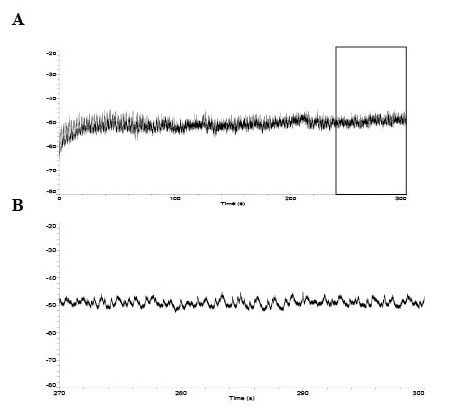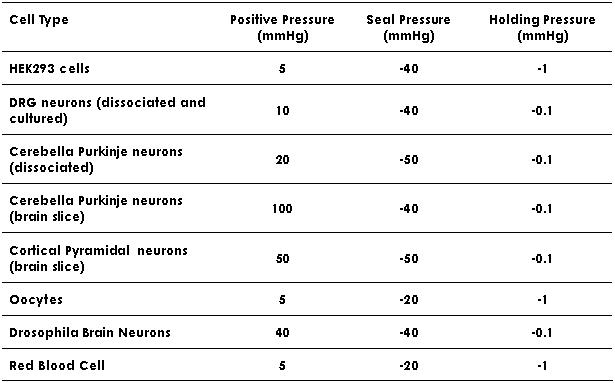In this issue
From the Editor
Application Notes
Technical Information
Author Profile
Dr. Ellena McCarthy is currently a postdoctoral fellow in the laboratory of Michael Nitabach at Yale School of Medicine.
She obtained her PhD at the University of Virginia in Charlottesville in the laboratory of Carla Green, studying the structure and function of mammalian Cryptochrome
protein and their role in circadian rhythms. Her current research interests involve elucidating the interaction between electrophysiological membrane properties and
circadian transcriptional-translational feedback loops in PDF-secreting neurons in Drosophila. She is approaching this question by obtaining whole-cell patch clamp
recordings in intact Drosophila brains and also employing a variety of genetic and immunocyotchemical tools.

Author Profile Dr. Jin-Bin Tian is a postdoctoral scientist
in the laboratory of Dr. Mike X. Zhu at the Ohio State University.
He received his Ph.D. from Beijing Medical University. He has 6 years of experience and published 6 papers in peer reviewed journals in
electrophysiology field.

1407 Heckman Way
San Jose, CA 95129
Tel: 408-454-6026
www.NeoBiosystems.com
|

From the Editor
Welcome to Neo's Letter, a newsletter that provides a forum for scientists to exchange technical information and help each other improve technical
skills in the area of patch clamp technology. This issue includes two application notes from research labs using our ez-gSEAL Pressure Controller, and provides
information on what is needed for making seals and breaking in.
We welcome your technical notes for publication, and if we use your article in a future issue, your lab will receive a 10% discount on your next purchase of any
NeoBiosystems product. Please send any articles or feedback about this newsletter to info@neobiosystems.com. We look forward to hearing from you.



Improving Whole-Cell Patch-Clamp of Drosophila Brain Neurons
With the ez-gSEAL Pressure Controller
Ellena v McCarthy
Department of Cellular and Molecular Physiology
Yale School of Medicine
Introduction
Whole-cell patch-clamp of neurons in the intact brain of adult Drosophila melanogaster fruit flies is technically challenging for a number of reasons.
First, the intact brain of the fly is extremely small and difficult to work with in comparison to mammalian brain slices. Second, it is covered by a
connective tissue/glial sheath that must be overcome to access the cells of interest. Third, the cells of interest are frequently deep within the brain
tissue. Fourth, the cells of interest are frequently extremely small, with diameters less than 5 microns. The ez-gSEAL has been invaluable in increasing
the yield of quality recordings, by helping to overcome the third and fourth obstacles to whole-cell recording from adult fly brains.
Method
Whole adult fly brains were prepared and mounted in patch rig essentially identical to a mammalian slice rig, according to Cao and Nitabach, 2008.
MultiClamp 700B amplifier and pClamp9 software were used for recording. Glass pipettes were made from borosilicate glass (outer diameter 1.5mm, inner
diameter 0.86 mm) and pulled on a PP-830 puller from Narishige, followed by fire polishing using a Narishige forge. Pipette resistances were between
13-17 megaOhms.
Results
A whole-cell current-clamp recording from a small lateral ventral circadian clock neuron genetically tagged to express red fluorescent protein is shown in Figure 1.

Figure 1. Representative whole-cell current-clamp recording of small lateral ventral circadian clock neuron showing spontaneous rhythmic
oscillation of resting membrane potential. A) 300 second recording B) Magnification of the last 60 seconds of the recording in A.
The optimal ez-gSEAL protocol to achieve gigaseals was as follows: set pressure at 40 mmHg (P1) before entering bath, changed pressure to
-40 mmHg (P2) once the cell was contacted by the electrode, and then released the pressure to 0 mmHg once the seal reached great than 1 GOhm.
After achieving a stable gigaseal, the membrane was broken into using the following ramp protocol:
1st Step: -100 mmHg
Peak P: -250 mmHg
Ramp T: 5 s
Interval: 5 s
Number: 1
Incr P: -10 mmHg
These parameters first stepped the pressure to -100 mmHg and then ramped up the pressure to -250 mmHg. The entire ramp was 5 sec in duration.
The ramp was interrupted by pressing P3, the holding pressure, as soon as the membrane was broken. If break-in was not achieved on the first
try, this protocol was repeated, incrementally increasing the ramp duration (Ramp T). If a clean gigaseal was achieved, break-in was
successful at almost every attempt.
Discussion
The use of consistent positive pressure delivered by the ez-gSEAL pressure controller was invaluable in allowing penetration of the preparation
to the depth required to access the small lateral ventral circadian clock neurons, which are in the accessory medulla region of the fly brain.
Because these neurons are so small, high-resistance pipettes with quite small tip diameters are required. This mean that the once a gigaseal
is formed, it can be difficult to break in, and the difference between the amount of negative pressure required to break in and the amount
that would damage the seal are close together. This means that with mouth or syringe delivery of suction, a slight error in delivering too
much suction will ruin the recording. Accordingly, the highly repeatable delivery of suction to break in provided by the ez-gSEAL pressure
controller substantially increases the yield of good recordings we obtain from this difficult electrophysiological preparation. In addition,
the capability of the ez-gSEAL to deliver a ramp of pressure, as described above, is a significant improvement over a square pressure step
(i.e. -200 mmHg for 500 ms), as it decreases the chance of interruption to the gigaseal.

Using the ez-gSEAL Pressure Controller
for Whole Cell Patch Clamping of Various Native Neurons
Jin-Bin Tian, Ph.D.
Department of Neuroscience
The Ohio State University
Introduction
When performing whole cell patch clamp experiments manually, patch clamp scientists face the same technical challenges. Not only do they need to know
how to apply a constant positive pressure to the patch pipette to prevent the pipette tip from clogging, the right speed to switch to negative pressures,
and the ideal amount of negative pressure to apply to the patch pipette to help form high quality tight seals (giga ohm level) between the patch pipette
and the target cell, but they also need to know how to perfectly control the negative pressure pulse to break-in a cell to form a whole cell configuration.
After you have learned the best method of making seals and breaking in, yet another challenge lies ahead: to be able to perform the steps with consistency
while dealing with your emotional and physical conditions. It becomes even more challenging when the information must be passed on to other people. Therefore,
it is desirable to have a piece of equipment to control pressure settings quantitatively so that optimal pressure conditions can be determined and applied
for patch clamping. The ez-gSEAL 100A Pressure Controller is designed to quantitatively define and automatically apply pressure settings for patch clamp
studies. This article shares my experience of using the ez-gSEAL 100A Pressure Controller to make seals on brain slices and dissociated neurons.
Material
Dorsal root ganglia neurons were dissociated from adult mice and cultured overnight. Cerebellar Purkinje cells were dissociated from postnatal P13-P17 mice
and used right after dissociation. Horizontal or sagittal brain slices (250-350 µm) were cut from brain tissue dissected from the adult mice.
A HEKA EPC10 Patch Clamp Amplifier coupled with PatchMaster Recording Software were used for the whole cell patch clamp recording.
Glass pipettes were made from capillaries (A-M System, INC. Catalog#: 61700) and pulled on the PC-10 micropipette puller from the Narishige Group, using the
two-step pulling protocol. The final resistance of the recording pipette after the internal solution was filled was approximately 3-7 MOhm, depending on the
composition of the internal solution.
Seal Method and Results
I tested this pressure controller on a number of specimens. It not only worked very well on cultured cells like HEK293 cells, but also on acutely dissociated
DRG neurons, and even on cells from brain slices. However, I need to work out different sets of parameters for each specimen. Once the right parameters are set,
the rest of the work becomes very easy and consistent. It has definitely helped me improve the success rate of high quality patches and it is very easy to
operate. I just need to click one or two buttons in the software that control the controller at each step during patching; the software and the machine take care
of everything else automatically. In most cases, after a few clicks, the whole cell configuration is already well accomplished. The whole operation just takes a
couple of seconds.

Making Seals
The NBSController Software, a free software that comes with the ez-gSEAL 100A Pressure Controller, provides three buttons for making seals. The process of making
seals is accomplished by clicking the buttons. P1 is usually to set the positive pressure to prevent the patch pipette from being clogged when the patch pipette
approaches the cell membrane; P2 can be used to set the negative pressure for making seals; and P3 is used to set the holding pressure that keeps the seal stable.
For brain slices, I usually use high positive pressures to prevent the electrode from clogging. For dissociate neurons, I found that if high positive pressure is used,
the seal success rate becomes lower. The parameters I used for making seals for different samples are listed in Table 1. After applying P2 pressure, if I see pipette
resistance increase quickly to more than 150 MOhm, I will click P3 and wait until the giga seal forms. In most cases, as soon as the negative pressure is applied, a
giga ohm seal can be reached within seconds. Usually the success rate of making seals can reach at least 90%.
Table 1 Parameters for making seals and breaking in for different cell types. P1: the positive pressure applied when the
patch pipette approaches the cell. P2: the negative pressure for making seals after the patch pipette touched the cell membrane.
P3: holding pressure. Added: the parameter for minor adjustment during breaking in. Peak: the amplitude of the square pulse used
for breaking in. Duration: duration of the pulse for breaking in.

Breaking-in
Although the ez-gSEAL 100A Pressure Controller can apply a train of pulses with gradually increasing amplitudes for breaking in, I usually set the breaking in
pressure manually as I feel it gives better control.
Depending on the individual cell, the breaking in pressure can be slightly different. Table 1 shows the average pressure for breaking into different types of
cells. When I break into a cell, I usually start with a pressure slightly below average. For instance, for brain slices, I usually start at -90 mmHg. When I click
the button to apply the suction pressure, I monitor the seal pulse for capacitance change. If I see the pulse shake with a hint of possible capacitance increase,
I will apply the same pulse again. Typically, repeating the same pulse a couple of times will guarantee a good, clean break-in. If the seal pulses show no hint of
break-in when applying the suction of pressure, I will increase the peak amplitude 5 or 10 mmHg, depending on the situation, and repeat the same procedure. It is
not uncommon that a good whole cell configuration is formed a few seconds after the first pulse administration, and sometimes after the second or the third pulse of
the same level has been applied. Following this procedure, my success rate of break-in is around 90%, and seals usually last during the entire experiment (up to an
hour). The figure below shows some current clamp records from brain slices.

Figure 1 Whole-cell current clamp recordings of neurons in mouse brain slices. Whole-cell configuration was made with the help of the ez-gSEAL 100A
Pressure Controller. A. Spontaneous firing of a cerebellar Purkinje cell. B. Induced firing of a lateral amygdala pyramidal neuron.
Discussion
After using the pressure controller for a few months, I was surprised by this instrument’s performance. It did a superb job of handling the technical
challenges I mentioned at the beginning of this article. The advantage of using the pressure controller is that the user can quantitatively set all key parameters
that determine the quality of the patch. In addition, because everything is quantified, it makes as subtle a change of patch parameters as possible and, therefore,
repeated application of optimal patch conditions is feasible. Also, because of the quantification, it accomplishes the accuracy and consistency that the hand operation
used by most patch clampers cannot compare to.
Due to its versatility, this pressure controller should offer great assistance to patch clampers at all skill levels. I feel that it is especially beneficial
to students and researchers who are new in the electrophysiology field because, with the help of this instrument, they can handle the apparently complicated patch
clamp technique easily and quickly. When I was learning the patch clamp technique, it took me a couple of months to practice all kinds of tricks using syringes and
manual switches to patch cells. Now, with the help of this instrument, I saw my colleague who had no prior experience in electrophysiology, patch a dozen HEK cells
in one day after just a few weeks of practice.

Technical Information
Making Seal Parameters
The tables below include making seal and breaking in parameters. From our experience, most labs can make seals easily with the parameters we provide. Break-in
parameters may vary somewhat, as the break-in pressure heavily depends on the tip size of the patch pipette. The larger the opening is, the smaller the break-in pressure is required.
Table 1 Making seal parameters for different cell types.

Table 2 Break-in parameters for different cell types. Since the required break-in pressure is depended on the tip size of the patch pipette, the resistances of the pipettes are included.

|